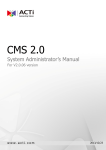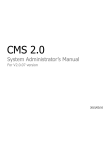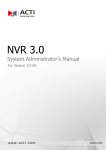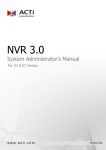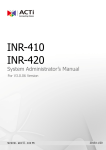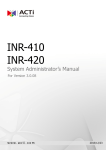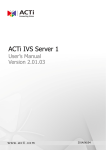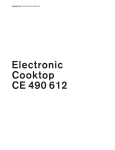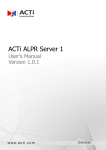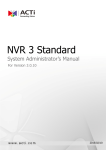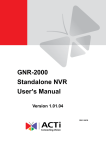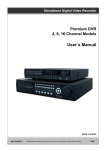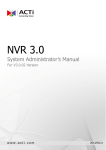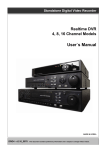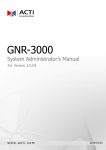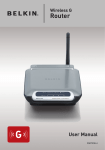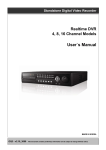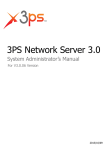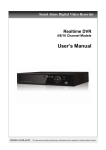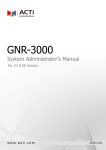Download CMS2 Administrator Manual
Transcript
CMS 2.0 System Administrator’s Manual For V2.0.01 Version 2013/05/17 CMS 2.0 System Administrator’s Manual About This Manual Target Audience This manual is intended for System Administrators who are responsible for installing and setting up CMS 2.0 surveillance system. The reader is expected to know the fundamentals of IP surveillance system integration and to own the administrative privileges to achieve all the configuration tasks. You may also check video management system section on ACTi corporate website: http://www.acti.com/CMS2 for updates or release information about this software and document. Content Overview This manual provides information needed for planning the installation, installing, setting up the system and configuring the video streaming devices. Its main content consists of the following three sections: Getting Started provides the preparatory knowledge you should study before starting installation, such as system requirements and license registration procedures. Log in to the System explains how to log in to the system right after a successful installation. System Setup gives instructions on administrative tasks such as centrally managing the NVR servers and the devices, setting up event rules, customize the live view layouts or managing system storage. For each major task, you will be given a brief introduction of operation principles, step-by-step instructions, and a simple tip to check if you have done it correctly. 2 www.acti.com CMS 2.0 System Administrator’s Manual Technical support If you have any questions during system installation, please feel free to contact our engineers via our Customer Help Desk platform http://www.acti.com/CHD. Conventions Used in This Manual The following are typographic conventions used in this manual: Bold: Bold typeface is used for a keyword, major functions of CMS, or a title of a section/column. Italic: Italic typeface is used for a filename or location path. Underlined: Underlined typeface is used for a document name or hyperlink. “Bold”: Bold interface enclosed in double quotation marks indicates the name of a button, a menu or a choice item. Some notices are placed within the following boxes; each type of the box indicates different purposes or levels of importance for system: Important Notice The content within this box is an important notice. This notice is important for you to get certain functions to work properly, or to prevent from certain potential problems that may damage your system. Make sure you read this notice and follow the instructions. Note The content within this box is a note. A note is some necessary information you need to know about the action you are currently taking, like what will happen after you follow or do not follow certain procedure. Tip The content within this box is a tip. A tip gives you an alternative method to easily or quickly achieve an objective, usually for specific conditions. 3 www.acti.com CMS 2.0 System Administrator’s Manual Related Documentation Since this manual focuses on how to accomplish the tasks for system installation and configurations, there is very limited information about operation-wise directions for End Users who will be operating CMS server system. To obtain the instructions on use of CMS applications such as monitoring and playback, please download the latest ACTi CMS 2.0 User’s Manual from ACTi Corporation website via http://www.acti.com/CMS2. 4 www.acti.com CMS 2.0 System Administrator’s Manual Legal Notice Disclaimer The information contained in this document is intended for general information purposes. ACTi Corporation shall not be liable for errors contained herein or for incidental or consequential damages arising from the furnishing, performance, or use of this manual. The information contained herein is subject to change without notice. The English version of this document is the official one for all purpose. All the translated versions are provided as a convenience. Any discrepancies or differences created in the translations of any other languages are not legally binding. Copyright Copyright © 2003-2013 ACTi Corporation All Rights Reserved. Trademarks ACTi Connecting Vision and its logo are registered trademarks of ACTi Corporation. Microsoft® and Windows® are registered trademarks of Microsoft Corporation. All other product or company names mentioned in this document may be trademarks or registered trademarks of their respective owners. 5 www.acti.com CMS 2.0 System Administrator’s Manual Table of Contents 1 About This Manual 2 Target Audience .................................................................................... 2 Content Overview ................................................................................. 2 Technical support .................................................................................. 3 Conventions Used in This Manual ......................................................... 3 Related Documentation ........................................................................ 4 2 Legal Notice 5 Disclaimer ............................................................................................. 5 Copyright ............................................................................................. 5 Trademarks ............................................................................................ 5 3 Table of Contents 6 4 Overview 10 CMS Server / Client Architecture ......................................................... 10 5 System Installation Check List 12 6 Getting Started 14 System Requirements .......................................................................... 14 Pre-requisites ....................................................................................... 15 1. 2. 3. 4. Upgrade all the NVR servers .............................................. 15 Suitable System Specifications........................................... 15 Uninstall Previous ACTi NVR or CMS Products ................. 15 Turn Off UAC in Windows ................................................... 15 Disable UAC in Windows 7 15 Disable UAC in Windows Vista 16 6 www.acti.com CMS 2.0 System Administrator’s Manual Server Installation ................................................................................ 17 Install the Software....................................................................... 17 Workstation Installation ...................................................................... 20 Install the Software....................................................................... 20 License and Activation......................................................................... 21 How Dose License Activation work .............................................. 21 How to Activate the Licenses ....................................................... 21 Online Activation 21 Offline Activation .......................................................................... 23 Verify Your License ....................................................................... 24 7 Log in to the System 25 Access CMS via Internet Explorer ........................................................ 25 From Server Computer Using Local Client ................................... 25 From Remote Client Computer .................................................... 25 Accept ActiveX Controls Installation Requests ............................ 25 Login Failure Troubleshooting ...................................................... 26 Condition 1: Why can’t I access NVR server via browser? 26 Condition 2: Why can’t I install Active X controls after logging in? 27 Login ............................................................................................ 29 Enter Account & Password 29 Change UI language 29 Remember Login Information 29 Set Auto Login 29 Access CMS Server via Workstation ..................................................... 30 Login ............................................................................................ 30 Server IP & Server Port 30 Choose the Initial Screen 30 8 Set up the System 31 CMS Main Screen ................................................................................. 31 Live View ...................................................................................... 31 Playback....................................................................................... 31 Setup............................................................................................ 31 Manage Users ...................................................................................... 32 Overview ...................................................................................... 32 7 www.acti.com CMS 2.0 System Administrator’s Manual User Groups................................................................................. 33 Add Users .................................................................................... 35 Domain Users Management ........................................................ 37 Manage NVRs ...................................................................................... 38 Add an NVR ................................................................................. 38 Synchronize Device Settings 40 Manage Multiple NVRs ................................................................ 41 Search an NVR 41 Delete NVRs 41 Synchroinze with All Devices 41 Configure NVR / Devices Settings ............................................... 42 Access NVR Settings 42 Event Management ............................................................................. 43 How to Edit an Event Rule ........................................................... 44 NVR Status Event Rule 44 Device Status Event Rule............................................................. 46 Manage the Event Rules .............................................................. 47 View the Event Rules 47 Delete the Event Rules 47 How to Setup SMTP Settings for Event Rules ............................. 48 System Log........................................................................................... 50 CMS System Log ......................................................................... 50 Search Time 50 Log Type 51 User Account 51 NVR Source / Device 51 Read the Log ............................................................................... 52 Export the Log ............................................................................. 53 NVR Source System Log ............................................................. 53 Customize Views .................................................................................. 54 Live View Interface Overview ....................................................... 54 Step 1: Create a New View .......................................................... 55 Step 2: Enter Edit Mode ............................................................... 55 Step 3: Select a Layout ................................................................ 55 Step 4: Add Video Source ............................................................ 56 Step 5: Add a Map ....................................................................... 56 Step 6: Add Devices to the Map ................................................... 58 Step 7: Adjust the Channel Size & Layout .................................... 59 8 www.acti.com CMS 2.0 System Administrator’s Manual Step 8: Save the View .................................................................. 59 Step 9: Set Default View ............................................................... 60 Set Default Hotspot Channel ........................................................ 60 Manage the Views ........................................................................ 60 Set View Link ............................................................................... 61 Set View Patrol ............................................................................. 61 Let Windows Automatically Starts up CMS Live View .................. 63 Customize System Language ............................................................... 64 Login Screen the Languages List ................................................. 64 Display Configurations ........................................................................ 68 Video & Snapshot Export Configurations ............................................ 69 Joystick 70 How to Install the Joystick ............................................................ 70 Un-install Server Software ................................................................... 71 Step 1: Remove CMS Server Program ........................................ 71 Step 2: Remove CMS Server Program Folder (Optional) ............. 72 9 Back up System Data 73 Step 1: Back up CMS System Settings ........................................ 73 Step 2: Back up CMS System Log (Optional) .............................. 74 Step 3: Back up NVR Source Backup (Optional).......................... 74 10 Restore System Data 75 9 www.acti.com CMS 2.0 System Administrator’s Manual Overview Designed for large-scale multi-site video surveillance solution, Central Management System 2.0 (hereafter referred to as CMS) software allows its user the full capabilities to monitor and manage multiple Network Video Recorders (NVR) via network. It also possesses full functionalities to manage not only NVRs but devices (network cameras, video encoders, etc.), users and events. CMS Server / Client Architecture CMS is a typical web-based server/client system. In a multi-site surveillance solution, CMS Server serves as a management command center; a Client makes requests of monitoring video streams or playing recordings to CMS Server, and CMS Server will pass this request to the involved NVR Server to send data/video stream to the Client. CMS Server starts automatically as soon as the Server computer (where it is installed) boots up, and operates in the background without requiring login by administrator. It would provide services over the TCP/IP network to multiple Clients upon request through HTTP Protocol. There are two types of Clients in CMS system: Web Client and Workstation Client. A user, connecting from whether web browser or workstation, will be provided with the same user interface and be CMS functions. Web Client: the web version of interface to access CMS Server without need of installing any client program to become a client. Logging in to the CMS Server is as simple as visiting a website through the browser. Workstation Client: the client application making accessing CMS Server free from the use of browser .The workstation includes a set of programs that provide interface between users and the CMS Server. 10 www.acti.com CMS 2.0 System Administrator’s Manual 11 www.acti.com CMS 2.0 System Administrator’s Manual System Installation Check List Pre-installation Item 1 Task Prepare software license Description Please purchase the license from your system supplier and get the license information before activation. Make sure the computer’s hardware spec, operation system and browser version are compatible with CMS system requirements. 2 Prepare the server computer 3 Assign a fixed IP for server computer The server computer should have a fixed IP to be used by CMS server. 4 Set up Active Directory (Optional) To add users through the Active Directory service, please make sure an Active Directory server is available on your domain. Reference How Dose License Activation work on page 21 System Requirements on page 14 Pre-requisites on page 15 Installation Item Task Install ACTi CMS 2.0 server software Description Follow the instructions to install the software on server computer. 6 Check if the installation is successful 7 Activate the license (Optional) Log in to CMS to check if you can see the login page. (On server computer, type http://localhost:[port number] in browser’s URL bar). Activate your license key to get your required number of channels ready for adding devices. 5 Reference Server Installation on page 17 Log in to the System on page 26 System Setup Item Task 8 Connect external devices 9 Description Reference Joystick on page 70 Create User Groups & Accounts Attach external devices such as the joystick, speakers or microphone to the client computer. Configure user group permissions and create required user accounts. 10 Add NVR source to CMS server Add NVR servers and configure their settings. 11 Configure Email settings Fill in the Email properties and test if CMS server succeeds in sending emails to the test email address. This step is necessary if you will use this service for event handling. Add an NVR on page 32; Configure NVR / Devices Settings on page 42 How to Setup SMTP Settings for Event Rules on page 48; 12 devices, and Manage Users on page 32 www.acti.com CMS 2.0 System Administrator’s Manual 12 Configure Event rules Set up the event rules. How to Edit an Event Rule on page 44 Live View Setup Item 13 Task Create Views for users Description Create views and set patrols. Reference Customize Views on page 54 Backup System Settings Item 14 Task Create a system settings backup Description Create a backup file of current system settings for future re-installation or in case of critical system failure. Reference Back up System Data on page 73 Post-installation Validation Item Task Description 15 Check Live View and monitoring-related operations 16 Examine Event Handling rules Make sure if the user is able to see live view with pre-defined Views and perform basic operations (e.g. PTZ controls, sending out audio or watching instant playback). Check if the expected actions (e.g. pop-up windows, beep alert, email notification, etc) are triggered by events. Make sure the user can access CMS with given account/password, and perform operations based on given user rights. Make sure the user can perform playback and video search, and the export function can generate viewable files to designated folder. 17 User Access 18 Playback 13 Reference User’s Manual www.acti.com CMS 2.0 System Administrator’s Manual Getting Started System Requirements The performance of CMS is largely determined by the computer hardware capability. The table below provides basic guidelines for selecting proper hardware (*1). The Minimum Requirement will provide acceptable performance for systems, for a system that has more than 1600 channels or more than 16 live view channels should satisfy Recommended Requirement for good performance. You can make use of the utility PC Selector available on www.acti.com/pcselector to select proper PC hardware in just a few clicks. PC Spec CPU Display Mode Number of Channels Live Layout (*2) 1-16,00 Server PC+ Local Client 1-16 Intel Core 2 Quad 2.4 GHz Intel i5 2.4 GHz 17-100 Intel i5 2.4 GHz Intel i7-920 2.67 GHz Server PC No Live View Intel Core 2 Quad 2.4 GHz Intel i5 2.4 GHz Remote Client PC 11-16 17-100 Intel Core 2 Quad 2.4 GHz Intel i5 2.4 GHz Intel i5 2.4 GHz Intel i7-920 2.67 GHz RAM Operation System Browser 1,601-unlimited 4GB 32/64 bit: Windows 7, Windows Server 2008, Windows Server 2003 SP2, Windows XP Professional SP3 (*3) Microsoft Internet Explorer 8.0 and 9.0 Network Ethernet (1000 Bas-T recommended) Display Minimum Resolution: 1024 X 768 or higher *1 These specifications are based on following camera settings: Single stream mode 1280x1024, 3Mbps, 18fps, MPEG-4 Dual stream mode1280x1024, 3Mbps, 18fps, H.264 (recording); 640x480, Quality: 100, 18fps, MJPEG (live view). *2 Live view for multiple channels require good hardware for smooth performance. If your live view performance is not satisfactory, please reduce the number of channels viewed at the same time, and use Layout Patrol to scan through all the channels or views instead. *3 Please make sure your operation system is fully patched with the latest service packs. 14 www.acti.com CMS 2.0 System Administrator’s Manual Pre-requisites Please preview these prerequisites below and make sure they are met before installation: 1. Upgrade all the NVR servers Please upgrade all the NVR 3.0 servers to the latest version. 2. Suitable System Specifications Ensure that the server computer meets the minimum system requirements. 3. Uninstall Previous ACTi NVR or CMS Products As ACTi NVR server or previous CMS server software (CMS1.X) cannot co-exist with CMS 2.0 server on the same computer, please uninstall their main program and patches from Windows Control Panel before installing CMS 2.0. Please also manually delete the program folder. By default, this folder ACTi Corporation is under C:\Program Files. 4. Turn Off UAC in Windows UAC (User Access Control) is a security setting that restricts access in Microsoft Windows Vista and Windows 7. You must disable UAC before installing NVR in Windows Vista and Windows 7, for the installation of application components and certain program features would be interrupted by this security rule. You may disable UAC through Windows control panel. Disable UAC in Windows 7 1. Go to Windows Control Panel, type “UAC” in search box. 2. Click “Change User Account Control settings” 15 www.acti.com CMS 2.0 System Administrator’s Manual 3. Move the slider to “Never notify position”, and then click “OK”. You will have to restart the computer for this change to take place. Disable UAC in Windows Vista 1. Go to Windows Control Panel, click “User Account and Family safety”. 2. Select the account, then “Turn User Account Control on or off”. 3. On the "Turn on User Account Control (UAC) to make your computer more secure" window, uncheck the "Use User Account Control (UAC) to help protect your computer". Click on the “OK” to apply, you will have to restart the computer for this change to take place. 16 www.acti.com CMS 2.0 System Administrator’s Manual Server Installation The server program installation is as easy as 1-2-3 by following the installation wizard’s instructions. The server would start its service right after installation completes, without the need to restart the server computer. Install the Software 1. Execute “ACTi_CMS_Server_v2.0.01.22.exe” installation application. 2. Follow the onscreen instructions of Install Shield Wizard, accept the license agreement and proceed. 17 www.acti.com CMS 2.0 System Administrator’s Manual When selecting Setup Type, the default “Complete” will have the program installed on default C drive, you may select “Custom” to choose another program location. 3. The IP Port Checker will pop up to confirm the CMS port number. The installation program will use 80 as default. You may enter another available port number in “Listen Port” field and click “Apply”. You may just click “Apply” if you are not sure whether this port has been taken or not. If the port is being used by another service, you will be asked to input another available port number. 18 www.acti.com CMS 2.0 System Administrator’s Manual 4. As the server port is confirmed, the installation process is done, click “Finish”. 5. After the installation completes, connect to http://localhost:port number with Internet Explorer browser, you will see CMS Login page. Note If IIS Web Server has been installed on the computer and you are asked to restart the computer during installation process, please 1. Choose to restart right away. 2. After the computer reboots, this install shield will automatically continue the installation. 19 www.acti.com CMS 2.0 System Administrator’s Manual Workstation Installation CMS2 Workstation provides interface between users and the NVR server. It may be installed on the same computer with the server or on a separate computer with internet access to CMS server. Install the Software 1. Execute “ACTi_CMS_Workstation_Install_v2.0.01.exe” installation application. 2. Follow the onscreen instructions of Install Shield Wizard, accept the license agreement and proceed. 3. After the installation completes, double-click the shortcut on desktop to execute the application. 20 www.acti.com CMS 2.0 System Administrator’s Manual License and Activation In CMS system, the maximum number of channels is umlimited; your required number of channels should be licensed and activated before adding the devices to the system. To get the license, you may contact ACTi sales representatives to purchase the licenses and obtain the License Key. Upon the activation of license with the License Key, the channels will automatically become available. Please note: ●The license is cumulative and perpetual. ●The license is not version-specific, software version upgrading will not influence the existing license you have activated on NVR server. How Dose License Activation work License activation is the process of unlocking the channels on CMS server with the received License Key. License Key is a serial number delivered as a printed card or by email after the purchase is carried out. During license activation, your License Key is matched against the MAC address of the Network Interface Card (NIC) on CMS server computer. Once this license key is used by the computer with given MAC, it cannot be activated with another MAC. This matching record will be stored on the activation database. If your computer has more than one network cards, CMS server will detect them and provide you a dropdown list to select from. How to Activate the Licenses There are two ways to activate the licenses depending on your CMS server network condition: Online Activation If there is available Internet access your CMS server computer, you should take online activation. Purchase licenses 1 from ACTi, get the LLIICCEENNSSEE KKEEYY On CMS2 server, input the 2 LLIICCEENNSSEE KKEEYY to activate the license directly. CMS server (Internet access) 21 www.acti.com CMS 2.0 System Administrator’s Manual Step 1: Membership ID in ACTi Member Center is required for activation. Register one for free at http://member.acti.com/ Step 2: Log in CMS server, go to Setup pageSystem tabLicense“Online Registration”. Select the MAC Address, enter your License Key, member Account and Password, and then click “Apply”. CMS server will connect to the activation database via Internet to register the license key, and unlock the channels. 22 www.acti.com CMS 2.0 System Administrator’s Manual Offline Activation Offline activation does not require Internet access for CMS server. It is used when CMS is located in a network not connected to public Internet (e.g. in a restricted military base). You will need to get an activation file (AUL.lic file) from another computer and transfer it to CMS server computer. Purchase licenses 1 from ACTi, get the LLIICCEENNSSEE KKEEYY On another computer, access 2 ACTi website to activate the licenses using the LLIICCEENNSSEE KKEEYY Computer (Internet access) Load the 3 AACCTTIIVVAATTIIO ONN FFIILLEE into CMS2 server CMS server 1. Membership ID in ACTi Member Center is required for activation. Register one for free at http://member.acti.com/ 2. Access http://www.acti.com/support/LicenseMgt/CMS_registration.asp, enter the License Key and the MAC address of CMS server computer, click “Submit”. An email with activation code file (AUL.lic) will be sent to your registered email account. 23 www.acti.com CMS 2.0 System Administrator’s Manual 3. Log in CMS server from local or via web client. Go to Setup System tab License “Offline Registration” click “Import” and upload the license file (AUL.lic). Click “Apply” to activate this license. Verify Your License Once your license is successfully activated, the license information will be shown on License page. Activated Licenses Important The license data will be erased once CMS server is uninstalled. Be sure to retain your license key information in a safe place because youImportant may needNotice to reinstall the software. After the software is uninstalled, you should contact ACTi Customer Help Desk http://www.acti.com/CHD to clear the original registration data in our database, and then you may activate the license again. Tip 1. How to find MAC Address 1. Click Windows Start, in the run box on Start menu, input “cmd”. Tip 2. Execute the cmd program, and input the command “ipconfig /all” or “getmac” 3. The MAC address will be referred to as the Physical Address, made up of 12 characters e.g. 00-1E-65-FE-8E-98 24 www.acti.com CMS 2.0 System Administrator’s Manual Log in to the System Access CMS via Internet Explorer From Server Computer Using Local Client Open Internet Expolrer. If your computer is where CMS server is installed, type http://localhost/ or the computer’s ip address in URL box. From Remote Client Computer A remote client refers to any client using a computer over WAN or LAN other than server computer. If you are connecting to a CMS server as a remote client, please type server computer’s ip (e.g. local network ip: http://172.16.26.217 within LAN; public IP http://220.228.146.21 or domain name http://cms.acti.com over WAN ) in URL box. If the port number is 80, you can omit it when typing the address. Accept ActiveX Controls Installation Requests CMS interface requires the add-on ActiveX Control components, please make sure browser’s security settings allow ActiveX controls to be downloaded and installed. When your browser asks if you allow ACTi Corporation’s add-on components to run, please allow them. 25 www.acti.com CMS 2.0 System Administrator’s Manual Login Failure Troubleshooting Once you confront with problems accessing NVR server, refer to the possible conditions below and follow the instruction to solve your issues. Condition 1: Why can’t I access NVR server via browser? After typing in the correct CMS server IP, if you cannot access CMS Login page, you may get the below browser screens: Cause 1: Server is not ready Solution: It may happen when you just started the server computer or the server installation has just finished, please wait a few seconds and connect again. Cause 2: This may happen when your CMS server uses default port 80. Server is not able to respond to your request through current path because port 80 has been seized by another service running on server computer, and that service is executed right before CMS server starts its services. Solution: Please check if there is another service using port 80 right now (e.g. Skype), and change the setting in that program to release port 80 for CMS server. Below are the steps to find the service: 1. Please click on "Windows Start" (Windows-Logo) , then enter "cmd.exe" in the run box and execute it. 2. Input the command “netstat -a -o -b”. You will be provided with the ports in use and the services using them. Find the Local Address that has taken port 80, and the PID number. 26 www.acti.com CMS 2.0 System Administrator’s Manual 3. Press down “ctrl”+ “alt” + “Delete” keys to bring up Windows Task Manager. Select “View”, and then “Select columns”, and enable the “PID (Process Identifier)” to appear on search results. Please also make sure “Show process from all users” is enabled. 4. On Task Manager Process tab, locate the PID number of the service using port 80. The service name is shown under “Image Name” column. Condition 2: Why can’t I install Active X controls after logging in? ActiveX Control components are essential for CMS server to present user interface. The message below will show if these controls were not installed. 27 www.acti.com CMS 2.0 System Administrator’s Manual Cause 1: Your Internet Explorer browser version does not support CMS. Solution: Make sure you are using IE8 or IE9 32-bit version. Cause 2: Your browser restricts the installation of add-on components. Solution: Internet Explorer security settings may restrict the installation of add-on components. To ensure CMS server is always accessible from your web client regardless of any change in browser’s overall Internet security settings, you may add CMS server site to Internet Explorer’s Trusted sites. These sites are which you consider safe and wish to visit with low security restrictions while maintaining higher security for the rest of the Internet. 1. On IE browser, click Tools Safety and make sure ActiveX Filtering is unchecked. 2. On IE browser, go to Tools Internet OptionsSecurity tab, select “Trusted sites”, set the security level to “Medium High”, and then click “Sites”. 3. Add http://localhost or server IP to the zone, and clear the box “Require server verification (https:) for all sites in this zone”. 4. Back on Security tab, click “Apply” to apply the changes. This will allow ActiveX and scripting to be available for the chosen sites but not for the Internet as a whole. 28 www.acti.com CMS 2.0 System Administrator’s Manual Login Enter Account & Password ●Account (non case-sensitive): Admin (default) ●Password (case-sensitive): 123456 (default) Change UI language To change UI language, select the desired language from “Language” dropdown list. Remember Login Information To have the server remember your Login name, password and language setting for future, check “Remember login info”. Click “Don’t remember” will clear your input text and reset to default. Set Auto Login Check “Remember login info” then “Auto Login” to skip the Login page and go directly to the main page every time you log in from this PC in the future. If your computer may be accessed by someone without proper authority, please DO NOT use either of these functions. To cancel auto-login, on title bar, click “Logout” to return to login page, and this function is cancelled. 29 www.acti.com CMS 2.0 System Administrator’s Manual Access CMS Server via Workstation CMS Workstation includes a set of programs that provide interface between users and the CMS server. It may be installed on the same PC as the CMS server, or they may be installed separately and connect to CMS Server via network. Double-click the shortcut icon on your desktop to execute this workstation application. Login Fill in the following fields then click “Login” to log in to the system. The login process of Workstation is very much the same as that of Web browser except for the following: Server IP & Server Port ● In Server IP field, key in localhost or 127.0.0.1 if CMS Workstation is on the same computer with CMS server. If you are connecting from another computer, please input the ip address of server computer, for example: 220.228.146.22. ● In Server Port field, key in the default port number 80. Choose the Initial Screen CMS user interface consists of three main module screens: Live View, Playback and Setup, you may choose one where you would like to enter after logging in. Default is Live View screen. 30 www.acti.com CMS 2.0 System Administrator’s Manual Set up the System This chapter will guide you through everything you need to know in System Setup procedure from first time connection with CMS server to general system configuration. CMS Main Screen On the right are link buttons to three CMS major functions: (1) Live View, (2) Playback and (3) Setup. You can click the orange button to enter the function page. Live View In this module, you can see live view from NVRs, perform PTZ operations with a mouse or a joystick, view system log, receive alerts on the event panel, setup view layouts, perform manual recording or take a snapshot. Playback You may find and playback existing recordings in this module. Up to 100 channels can be played synchronously. Snapshots or video segments can be taken from playback files. Recorded files can also be exported to AVI format here. Setup This module includes user setup, NVR/device setup, event setup, schedule setup and CMS system-wide settings. 31 www.acti.com CMS 2.0 System Administrator’s Manual Manage Users The User Groups/Users page allows you to (1) manage the access permissions of different user groups, (2) add users to or delete them from user groups, (3) and assign users to specific user group. This chapter will take you through these settings. Access Permissions In CMS, the access permissions are managed by User Groups. User Groups defines which CMS operations and NVRs are allowed for the group user. Different User Groups will have different access rights. For example, an Administrator User is allowed for the complete operations in CMS system, while a standard User may only be permitted to do Live View and Playback with limited NVRs. The chart below displays different employees as CMS Users and their access rights in this system: Limited Group Monitor Security Group Playback Monitor Administrator Group Playback Setup Overview Go to Setup page Users tab. There are two sections to manage User Groups and Users individually. User Groups: To setup user groups and its permissions for device and functionalities. Users: To manage user accounts and configure user information. CMS has integrated Microsoft Active Directory® service to provide network administrators a more convenient choice for user management. Active Directory is a directory service built in Microsoft Server products to manage user identities and privileges within the domain network. As CMS runs on a server computer logged on to the same domain with Active Directory server, you can import a user account or a group from those concurrently existing in Active Directory into CMS server. In this way, the user identification is processed by Active Directory centrally, and there is no need for CMS administrator to maintain user accounts 32 www.acti.com CMS 2.0 System Administrator’s Manual User Groups You can specify access permissions to each NVR for a whole user group. This user grouping can save you significant amount of works if you have multiple users performing similar tasks and acting as similar roles. By default, the Administrator User is predefined with full permissions in the CMS server, and cannot be deleted. You can choose to create a new user group on CMS server or import an existing group from the active directory database within your domain. 1. Select , click “Add” and then choose the group type: ● Add a new user group: Insert ID, group Name and group Description, your input in the Name field will be the name of this User group. Click “Apply” to finish. ● Import a domain group as a User group: Choose an existing user group from your domain, and click “Apply” to finish. 33 www.acti.com CMS 2.0 System Administrator’s Manual The domain users within that group will all be added to CMS server at the same time. To check and enable the “Show users in domain these group users, please select groups.” These users, unlike those customized user accounts you would add one by one to CMS server, are not editable on Users page. Domain users added as a whole group 2. Assign NVR Permissions for created group. This will define what functions this User group is allowed to access. By default, a User group will initially be allowed to access only Live View page and Playback page on CMS, but without any permission to any NVR, so you will have to assign the NVR Permissions later. Live View page Playback page CMSSetup page 3. Assign NVR Permissions for created group. This will define which NVRs this User groups is allowed to access. If this User group is allowed to access later-added NVRs, check “New Device Default” and edit the permissions. New NVRs Exiting NVRs You may copy the Device Permissions Settings to other sources. Click “Copy” under Device Permissions tab to bring up the target device menu, check the target sources, and click “Apply”. 34 www.acti.com CMS 2.0 System Administrator’s Manual Click “Apply” on top to save the settings. Add Users You can create a user account with username/password authentication for CMS server. 1. Select , and click Add button. 2. Select User Type as Customized User or Domain User. By adding a Domain User, there is no need to input the account information as it has been created and under maintenance of Active Directory server. ●Customized User: an account created and managed on CMS server only. ●Domain User: an account that already exists in Active Directory database. 3. (For Customized User only) Insert Account, Name, Password, and the account Email. The Account and Password will be the credential used to log in to CMS server. 4. Assign the created user to a specific user group. 5. After you click “Apply”, this new user will be added to the list. 35 www.acti.com CMS 2.0 System Administrator’s Manual Note Account /Password Rules 1. Account and Password fields allow alphabets, numbers, and symbols except the following: / \ [ ] : ; | = , + * ? < > " 2. In Account field, for alphabets, the input will be recognized as lowercase letters. Space is only allowed between characters; the space in the beginning or at the end will be deleted when it is saved. 3. The Password field is case-sensitive, and the space is allowed. Note Admin is the default user account and belongs to “Administrator” user group. Hence, the user Admin and the group Administrator cannot be deleted; it possesses full permissions to all NVRs and CMS settings. 36 www.acti.com CMS 2.0 System Administrator’s Manual Domain Users Management As CMS server computer logged on to a domain Active Directory, it can import a user account from Active Directory. Domain: ACTi.com ACTi CMS 2.0 Server Active Directory Domain Controller This type of User account is “Domain User”. Upon being added to CMS server, the User properties stored on Active Directory database including account name and email address will be imported to CMS server. Whenever the Domain User client tries to log in to CMS server, CMS server will first verify if this account exists in CMS server database, then will have Active Directory verify the user account and password. As Active Directory owns the privilege to create, edit and delete domain users, the Domain User’s account and password are not editable through CMS user interface but via Active Directory Administrative Tool. 37 www.acti.com CMS 2.0 System Administrator’s Manual Manage NVRs A CMS server manages multiple NVR severs, whose fundamental building blocks are the cameras or video encoders. The first thing you should do after you have registered license is to setup your NVR connections in CMS Setup page. In this section, we will guide you through how to manage the NVRs and their devices. Add an NVR To start adding a new NVR, please follow steps as below: 1. On Setup page click “Source”. There is 0 source in All Sources list. Now click “Add Source”. No NVR 2. On the Add Source window, fill in the following fields and click “Apply”: ●Name - title of this NVR ●Host - the NVR’s IP address ●Port - the NVR’s port number ●Password - the Administrator’s password of this NVR. By default, all the devices in the NVR will be 1 automatically added to CMS server after you click “Apply”. If you want to select the desired devices later rather than import all the devices at this stage, unselect “Auto import all devices in source” before clicking “Apply”. 38 www.acti.com CMS 2.0 System Administrator’s Manual Under All Sources category will appear the new NVR. Import Devices from NVRs In most cases, with limited licenses, you would not decide to import all devices existing in all NVRs to your CMS server. After an NVR is added, you may start selecting your desired devices to import to CMS server. Once a device is imported, on CMS interface you can (1) modify this device directly, (2) see live stream and (3) receive the instant event notifications from this device. 1. On All Sources list, select this NVR, the Using Devices list will display the imported devices on the right. By default, all the devices of an NVR are imported by the time you add it to CMS server. Added NVR Imported Devices: All 2. Click “Import Devices” to enter NVR device list. 39 www.acti.com CMS 2.0 System Administrator’s Manual 3. On the Import Devices list will show all devices of this NVR. Select the desired devices you want to import and click “Apply”. Selected Devices: 1 and 4 4. The Using Devices list will be updated in accordance with your selection on Import Devices list. Imported Device: 1 and 4 Synchronize Device Settings Some re-arrangements or configurations done to the NVR are not synchronized with CMS server actively. For example, an NVR administrator may replace several cameras (which have also been imported to CMS server) with new ones, and therefore the CMS site would lose the connections between those previous cameras. On CMS, you can always synchronize with an NVR server via one click: 1. Go to Setup page Sources tab, on All Sources list, select this NVR. 2. On the right, click “Sync Device” button. 3. Click “Apply”. Tip Whenever your CMS server loses connection with certain devices, it is always suggested that you click this button first, since the loss of connection probably resulted from some changes done on the NVR site. 40 www.acti.com CMS 2.0 System Administrator’s Manual Manage Multiple NVRs You may centrally manage multiple NVRs on the All Sources Setup List easily. Go to Setup page Sources tab. Under list all the NVRs you added. Search an NVR To locate a specific NVR in the All Sources tree, you may input the keyword in its name in the search bar, and then click to start searching, and click to show all sources. Imported Device: 1 and 4 Delete NVRs Highilight , a detailed NVR list will appear on the right. Select the NVRs you want to delete, and click “Delete” then “Apply”. Synchroinze with All Devices Highilight and click “Sync All Devices”, CMS server will synchronize with all the NVRs and imported devices. 41 www.acti.com CMS 2.0 System Administrator’s Manual Configure NVR / Devices Settings As CMS administrator owns unrestricted rights to control all the NVRs and their devices, it is sometimes more convenient to modify the NVR settings directly from CMS interface. On CMS Source management page, you may change any property of an NVR or its devices. Access NVR Settings To enter an individual NVR’s settings, Go to Setup page Sources tab, on All Sources list, select an NVR, and click on the arrow to expand its sub category. By selecting a title, the setup page will appear on the right. Any change applied to the NVR will be saved to both NVR itself and CMS server. Add Devices to this NVR by auto-search or manually NVR User Group/Permissions management NVR User Account management NVR Storage setup NVR System setup (Email/SMTP/FTP/Export folder/UI style) NVR License management NVR Backup/Restore/Language file management NVR Device list Device Connection/Video/Motion Detection/PTZ /Preset Tour /Schedule/Event setup Note Please note the following before applying any change to an NVR: 1. It is strongly recommended that you enter “Maintenance” to make a backup of the original NVR settings. 2. Only the devices in the same network segment with the selected NVR can be found or manually added by clicking “Add Device”. 3. To modify a device’s schedule or event rules, please select the device and enter the Schedule or Event tab on the right. 4. The customized views saved on an NVR server cannot be configured via CMS interface. 42 www.acti.com CMS 2.0 System Administrator’s Manual Event Management As each NVR server individually manages the events on the camera site or NVR site, the triggered responses would take place to notify NVR clients in various forms of actions. Under CMS management, an event detected by a single device can be notified to CMS clients at the same time. For example, once a camera detects a motion, both NVR client and CMS client would be alerted by a pop-up live view window. In addition, an NVR server’s abnormal status notification can trigger actions on CMS interface to notify CMS clients. To have CMS be notified with the events from devices and NVRs, please set up event rules in CMS Setup page Event tab. The event rules set here will be independent from those set on NVR. Motion is detected! CMS Event Rule Beep Alert Send e-Mail Camera NVR Server CMS Server Server disk is full! 43 www.acti.com CMS 2.0 System Administrator’s Manual How to Edit an Event Rule Go to Setup page Event tab. All the editable event rules are listed on the right. NVR Status Event Rule An event rule set for an NVR will trigger actions to notify CMS client. 1. Select an NVR source to edit an NVR event rule. There are seven types of NVR status that can be set as event triggers – Source Loss, Source Recovery, Schedule Service Start, Schedule Service Stop, Disk Full, Disk is Available and Disk Not Found. 2. Highlight the rule you wish to edit. Double-click the “Response” field to edit the response action. 44 www.acti.com CMS 2.0 System Administrator’s Manual 3. On Event Edit window, you can enable multiple response actions by first checking the box(es) to enable the items: Action Items Function Description Enables CMS server to play beep sound for a number of repetitions. Please make sure the sound device of your server computer is working. Enables CMS server to execute a specific command upon this event. You can use it to integrate CMS event with other programs. Enter the path of the command to be executed upon event. Enables CMS server to send an email notification via SMTP server. The default SMTP and sender’s email settings can be set in advance in Setup page System tabSettings Email& SMTP Settings. 1. Type one or more recipients’ email addresses in “To” column (if more than one, please separate them by “;” symbol) or click the icon to select recipients from existing NVR User list. The User’s Email address should be set in advance (in Setup pageUsers tabUsers) so that it can be selected in this list. 2. Edit the email subject and content. 45 www.acti.com CMS 2.0 System Administrator’s Manual Device Status Event Rule An event rule set for a specific device will trigger actions to notify CMS client. 1. Select an NVR, click the arrow to expand its sub-categories, and select the device. There are five types of device status that can be set as event triggers – Motion, DI Trigger, Video Loss, Video Recovery, Network Loss and Network Recovery. 2. Highlight the rule you wish to edit. Double-click the “Response” field to edit the response action. 3. On Event Edit window, you can enable multiple response actions by first checking the box(es) to enable the items: Action Items Function Description This kind of action will focus your attention on the channel on client’s Live View page when triggered. Pop-up: Brings up event pop-up playback window of selected channel upon trigger. You may also define the display duration of video on the window. Hot-spot: Displays video in Hot-spot window (red flashing frame) upon event. You may also define display duration of video on the Hot-spot window Enables CMS server to play beep sound for a number of repetitions. Please make sure the sound device of your server computer is working. 46 www.acti.com CMS 2.0 System Administrator’s Manual To validate if this rule is successfully set, please make sure you have properly configured the involved (1) triggering side settings like Motion Detection Regions or DI, (2) response side settings like audio speaker device in CMS server site. Manage the Event Rules Event List panel gives an overview on event rules set on the CMS server. Go to Setup page Event tab select All Sources on the left. As the entire available rules of all NVRs are listed here, you may want to sort out some of them from the long list. View the Event Rules To sort by NVR Source name or Event Name, click the titles to list the entries in ascending or descending alphabetic order. There are two event filters for you to quickly locate your desired event rule: (Edited Status) Events with Response Events without responses (Trigger Type) Source Status Schedule Service Status Disk Status Delete the Event Rules On Event List, select the rules you wish to delete, and then click “Delete” to clear this rule. 47 www.acti.com CMS 2.0 System Administrator’s Manual How to Setup SMTP Settings for Event Rules CMS supports email notification sent through an SMTP server. You can specify the email and server settings here. 1. Go to Setup pageSystem tabSettings Email& SMTP Settings. 2. Fill in each of the following fields. Field Name Description Server Input the sender’s SMTP server address. Only alphabets, numbers, and the symbols (.), (_), (-) are valid. NVR server does not support the SMTP services with SSL protocol. If you wish to use a free webmail SMTP service, you may choose certain webmail providers such as Yahoo (SMTP: smtp.mail.yahoo.com Port:25) or whose SMTP servers don’t require SSL authentication. SMTP Port Set the SMTP port, allowed value is from 1~65535, default is 25. Account Input the name of the SMTP server account. Only alphabets, numbers, and the symbols (@), (.), (_), (-) are valid. Password Input the password of the SMTP server account. Only alphabets and numbers 48 www.acti.com CMS 2.0 System Administrator’s Manual are valid. Sender Name Input the name or title of the sender. You may input a name different from the account name. Sender Mail Input the sender’s email address, should the same account you set for SMTP server. 3. As all necessary information is filled in, click “Send Test Mail” to try sending an email according to your settings, and then log in to your SMTP server to check incoming emails. If the test mail is sent successfully, NVR server is ready to send out emails. 4. As the settings are confirmed, click “Apply” to save. 49 www.acti.com CMS 2.0 System Administrator’s Manual System Log The activities performed by logged-in Users are recorded on server as System Log. With the access permission, a user may view, search and export this record for analysis or investigation. This section will provide the instructions on how to read and search data in the system log. “System Log” is one of the resident buttons on top of CMS server user interface, click it to enter either “CMS System Log” or “NVR Source System Log”. CMS System Log Upon entering the log page, you will be provided with a blank result list. After you define the searching criteria and click “Search” , the CMS System Log will search the activities performed on CMS. To start, please define the searching criteria. Search Time Default is your current client time. 50 www.acti.com CMS 2.0 System Administrator’s Manual Log Type You may filter the logs by activity Type. By default, all types are selected. User Account You may filter the activities performed by a specific user. NVR Source / Device You may filter the activities related to a specific NVR or a device. 51 www.acti.com CMS 2.0 System Administrator’s Manual Read the Log The search result will show 1000 records before and after your query time. You may click the pagination buttons to navigate earlier or later records. If there is an icon on the top right corner of an entry, click it to view the full description content. A log entry contains several kinds of information including Date Time, Type, User Account, Source, Device and Description. Check Type and Description fields to know what the user has done or what happened to the whole system. In Type field shows what major functions this behavior was involved in, in Description field narrates how the change was done (in green font color, uppercase) and the result (in white font color). Take the case below for example, you can tell that the admin user set up an event rule on 2013/4/25 for #1 device(11F_Entrance) on #2 NVR(MobileGo) to trigger a response upon the motion detected in #1 device(11F_Entrance)’s motion region 1. Note If the pagination button appears to be disabled, that means no more records are found on CMS server. By default, the server will keep the logs for 30 days. If you wish to adjust the period, please go to Setup page System tab Settings, in System Log Settings section, key in the value in this field: 52 www.acti.com CMS 2.0 System Administrator’s Manual Export the Log Click “Export” button to export the log as .csv file. You can specify the Time Duration, NVR Source, User Account and the involved Device of the logs, and click “Apply”. NVR Source System Log As the CMS administrator owns the same privileges of an NVR administrator, it is able to acquire the NVR system log from CMS interface. Unlike CMS System Log, NVR Source System Log record an NVR user’s activities on NVR. Click , enter Source System Log, specify the NVR Source name and other criteria, CMS will start searching. 53 www.acti.com CMS 2.0 System Administrator’s Manual Customize Views After all the NVR sources are added, you may start customizing the views for different needs. This chapter will teach you how to add video source, arrange the channels and manage live view layouts. In CMS system, a View refers to the layout where the live images of Cameras or Maps are arranged in proper positions to suit the monitoring purpose. This is very similar to a camera group, which often consists of cameras in the same physical location or with the same device functions. For example, a View named 11F Emap & Camera may contain the 11F floor plan and the cameras actually placed on 11F. Live View Interface Overview 1 View Tool Bar View 3 View List 4 Source List ist 2 Channel 1. View Tool Bar: Provides 24 options for layout styles and the functions keys for editing a view. 2. Channel: Each channel window may display a camera view or a map. In edit mode, you can adjust the channel size at will. 3. View List: All the saved Views are shown here. On Live View, you can go to View Manager to group and manage these views (refer to Manage the Views on page 60). 4. Source List: In edit mode, drag a camera from here to your desired channel. 54 www.acti.com CMS 2.0 System Administrator’s Manual Step 1: Create a New View On View Tool Bar, click the Create View button , input the View Name, add a New Group for this View and decide whether this group is to be Public or Private, and then click “Apply”. ● The views under Private View Group ● The views under Public View Group are only available to the User who created them. are open to every User. Step 2: Enter Edit Mode On View Tool Bar, click the Edit View button , this view will turn into edit mode. In edit mode, you may add a video source to a channel, and adjust the channel size. Step 3: Select a Layout On View Tool Bar, click the Expand button for all provided layout styles. Select a layout that is perfect for your required channel number and ideal arrangement. 55 www.acti.com CMS 2.0 System Administrator’s Manual Step 4: Add Video Source In edit mode, move the mouse over the channel and click to select a camera from the source list. You may also directly pull a camera from the Device panel to your desired channel. ●Remove the camera view: right-click on the channel and elect “Remove”. Step 5: Add a Map By adding a map, you put a picture on the channel, where you may place camera icons later to make it an “e-Map. In edit mode, move the mouse over the channel and click to upload a map. Please input the Map Name, select the image location (file format must be JPG) and click “Apply”. 56 www.acti.com CMS 2.0 System Administrator’s Manual ● Map brightness: To change the map brightness, right-click on the map, select “Map Mask” and the brightness percentage level. ● Map size: By default, the map will be displayed in its original size. Use the button s on upper right to adjust the map size. Enlarge to fill channel height Original image size Zoom in Zoom out ● Edit map title: The map title will be shown on channel title bar. In edit mode, right-click on a map channel and select “Edit Map Information” 57 www.acti.com CMS 2.0 System Administrator’s Manual ● Remove the whole map: Right-click on the map and select “Remove”. ● Manage maps: All the uploaded images are managed under Map Image Manager. On Live View screen, you may go to Map Image Manager to view, upload or delete the maps. Step 6: Add Devices to the Map Pull a device from Device List to the map. ●To remove this device from map: Click ●To move this device: Left-click on the device icon and drag. ●To change the pointed direction: Mouse over the viewing angle area, left-click on the clockwise arrow to turn the direction. 58 www.acti.com CMS 2.0 System Administrator’s Manual ●To adjust precise pointed direction: Right-click on the device icon, select “Pointed Direction”. ●To adjust device’s viewing angle: Right-click on the device icon, select “Vision Angle”. Step 7: Adjust the Channel Size & Layout ●Adjust the channel size: Click on right lower corner of the channel window, drag and then release. ●Switch channel windows: Click on a channel title until the cross arrow appears, hold it to drag this device or map to your desired channel. Step 8: Save the View Click on View Tool Bar to save it. 59 www.acti.com CMS 2.0 System Administrator’s Manual Step 9: Set Default View To set a View as default, select it in the View List panel and then click on View Tool Bar. By next time you log in, you will directly enter this View. Set Default Hotspot Channel By system default, the global hotspot channel will always be the top left one. You can set any other channel on your live view screen to be the default hotspot channel. Right-click on the channel and select “Default Hotspot” , then click on View Tool Bar to save it. Manage the Views Each View belongs to a specific View Group. With the group management, CMS makes it easy to deal with Views you created for multiple Users. After you created and saved the Views on Live View screen, click View Manager. 1. 1 Click on the arrow icon in front of a group folder to reveal its Views. 2. 2 By selecting a View, you may directly modify its name in Name field. 3. 3 You may change a group’s Group Type. Upon the change, for example, by changing a group from “Private” to ”Public”, all the views belonging to it will be open to every User. 4. 4 Click this icon to add a new group. 5. 5 Click this icon to delete a selected group. 6 Click this icon to copy a selected group to another group. 6. 7 Click this icon to move a selected group to another group. 7. 4 5 6 7 2 3 1 60 www.acti.com CMS 2.0 System Administrator’s Manual Set View Link By creating a link button on a view, you can directly be linked to another specific view. On the picture below shows how to create a link button to 7F View on 11F View. 1. Select a View, on which you will place a link button to another view. 2. Click on View Tool Bar to enter edit mode. 3. From View List, drag the target View to current View, a link button will appear. 4. Click on View Tool Bar to save it. Set View Patrol You may have the saved Views patrol in turns. In this way, the views in different area in your site may cycle through themselves for you automatically. 61 www.acti.com CMS 2.0 System Administrator’s Manual On View Tool Bar, click then Create Patrol. 1. Input the Patrol Name. 2. Select the Patrol Type to be open to all Users or to the creator only. 3. Define the Global Dwell Time between the views. If you want to set different dwell time length for individual Views, do not check this option, and configure them separately in below table. 4. Choose the Views to display in patrol. If you select the All Sources group, you will also need to select “Source Layout Style” for it. 5. Click “Apply” to save the settings. 6. The saved patrols will be shown on the patrol list after you click on View Tool Bar, you may delete and edit a saved patrol or select it to start patrolling. 62 www.acti.com CMS 2.0 System Administrator’s Manual Let Windows Automatically Starts up CMS Live View You may have the CMS client application automatically run and open the live view after Windows starts. In this way, you may save steps and time before you eventually see the desired live view screen. Additionally, whenever a power breakdown takes place, the live view may recover as soon as your computer resumes. If more than one users would log in to this computer, this tip might not be suitable due to account security issues. 1. On CMS server, set a Default View for your account. For detailed procedures, please refer to this section in this manual: Customize Views on page 54. 2. Set Auto-login for your Workstation client or web browser client. For detailed procedures, please refer to this section in this manual: Set Auto Login on page 29. 3. If you are using a browser client, open the browser, and set the CMS server ip as default homepage. 4. Set your browser or Workstation application to start right after Windows has started. Click Windows Start Programs Startup to open the Startup folder, and drag the application shortcut into it. In your case, you will have to drag the Internet Explorer shortcut or CMS2Workstation shortcut into the Startup folder. 5. The next time you start Windows, CMS live view will be running automatically, and you may start monitoring the system in no time. 63 www.acti.com CMS 2.0 System Administrator’s Manual Customize System Language NVR server supports multiple languages for user interface display. There are already 10 translated language files in the server system. Each language is open to customization based on your own needs. This section will describe how to choose or customize language strings for your site. Login Screen the Languages List You may decide which languages to be selectable on Login screen. The chosen languages will appear on the “Language” dropdown list. Go to Setup page Language tab, click “Active Languages”. On popup window, check the languages you need, and click “Apply”. By default, all languages are selected. As English and Traditional Chinese are the default system language, they are not removable from this list. 64 www.acti.com CMS 2.0 System Administrator’s Manual Edit User Interface Wordings Each language file contains four editable string tables. Each table displays the default wordings in English and the translation in target language. To view the string table: 1. Select the language from “Select Language” dropdown list, then select a table from the “Language Group” list on the left column. 2. Your target language will be displayed on the right column, while the default system language “English” appears on the left for reference. Click in any field on right column to customize your desired wordings, and click “Apply” to overwrite the current. 65 www.acti.com CMS 2.0 System Administrator’s Manual The new string will be applied by next time you log in. If you log in as an CMS2 Workstation client, please press button on Login page to synchronize with the latest modified language file, then log in to the system. Export / Import Language String File You may also click “Export” to export the language file as .xml format to edit in Notepad, or “Import” to import a language file to use in the system. 66 www.acti.com CMS 2.0 System Administrator’s Manual In general, it is suggested that you always save a modified language table with a different file name in a location other than default system language folder on server computer C:\Program Files\ACTi Corporation\CMS2\Language, then import it to use. In this way, you can avoid overwriting the original language file. 67 www.acti.com CMS 2.0 System Administrator’s Manual Display Configurations You can change the user interface style by arranging the main screen and Panel/Device List on the right or left. Go to Setup pageSystem tabSettings, scroll down to the User Interface Style section, select the setting style then click “Apply”. The change will be applied upon your next login. 68 www.acti.com CMS 2.0 System Administrator’s Manual Video & Snapshot Export Configurations The snapshots taken by Users on Live View and all exported video files are saved to a default file location the default location will be the connect client’s computer Desktop. You may configure the destination. Go to Setup pageSystem tabSettings, in Export Video Settings section, click “Browse” to choose the Export file path. You may also define what information is printed on each snapshot by checking the items: Date and time, Source ID, Device ID, Source Name and Device Name. These configurations will take place after you click “Apply”. 69 www.acti.com CMS 2.0 System Administrator’s Manual Joystick On CMS, other than user interface PTZ panel and mouse operation, you may also control the PTZ movements by physical controllers. NVR 3.0 supports two types of controllers, which both feature in a joystick and twelve buttons for users to assign specific actions. Model: Extreme™ 3D Pro Manufacturer: Logitech Model: IP Desktop Manufacturer: CH Products How to Install the Joystick 1. Log out from NVR server. 2. Connect the controller device to your computer. To make sure the device is installed properly, open Windows Start menu and enter Devices and Printers to check the status. 3. Log in to CMS server, go to Setup page System tab, enter “Controller” section and select your product. 4. You may assign specific commands from dropdown list to buttons 1~12 of the controller. When setting is done, click “Apply”. The modification you did on one controller model will be applied to the other joystick model as well. 70 www.acti.com CMS 2.0 System Administrator’s Manual 5. To validate its function, go to Live View page and focus on a PTZ device channel to operate the supported PTZ operations. Un-install Server Software In certain cases, un-installation of CMS system is necessary, for example, (1) you want to terminate CMS server and clear all the evidence due to privacy and security reasons, (2) you need to reinstall the system due to an unsuccessful installation. Before starting un-installation, please back up important data( please refer to Back up System Data on page 73) first and prepare the CMS server install shield application. This chapter will describe un-installation process. Step 1: Remove CMS Server Program 1. Go to Windows Control Panel Add/Remove Programs (in Windows Server 2003/Windows XP) or Programs Programs and Features (in Windows Vista /Windows 7/Windows 2008) to remove it. When you un-install NVR server program, the web client will be terminated at the same time. 2. After you choose to uninstall “ACTi CMS Server v2.0.01” program, the uninstallshield will execute and notify you when it is completed. 71 www.acti.com CMS 2.0 System Administrator’s Manual Step 2: Remove CMS Server Program Folder (Optional) If you are performing a complete un-installation without leaving any CMS server related data on the current computer, you may consider deleting this folder. After un-installation, the CMS system folder will remain under ACTi product folder ACTi Corporation on your hard drive, the system configuration data here will not be removed until you delete them manually. By default, the path of CMS system folder is C:\Program Files\ACTi Corporation. ACTi Product Folder CMS program folder However, keeping this folder is convenient for a un-installation followed by an instant re-installation, for the previous system settings can directly be applied to the new server. 72 www.acti.com CMS 2.0 System Administrator’s Manual Back up System Data Making regular system backups is always recommended in case of unexpected disasters or accidents that may damage CMS server. Other than this, you may need to perform an on-demand backing up to (1) migrate the whole CMS server data to another computer, or (2) re-install the CMS server on current computer. There are several types of data on CMS server essential to your surveillance system please consider your purpose and follow the below instructions to create their backups. CMS Settings Backup CMS server can create a backup file of the whole system settings within one click. The settings being backed up include the following properties you set for system: (1) Users (2) Imported NVR Source & Device properties (3)Event Rules (4) System Settings / User Interface Style / Joystick, and (7) the saved Views in Live View page. Step 1: Back up CMS System Settings 1. Go to Setup page System tab Backup / Restore 2. In Backup section, click “Browse” to select the destination for backup file, the file will be saved as Backup_YYYYMMDD.xml file. Then click “Backup” to export the file. 1 3 2 Important Notice 2. The license data is not included in the system backup file. You have to preserve the license key information provided in email or printed card to you after the purchase takes place. 73 www.acti.com CMS 2.0 System Administrator’s Manual Step 2: Back up CMS System Log (Optional) The system log records the operations Users perform during logging in to CMS server. You may export the system log of latest three days as *.csv file as backup. Please refer to the section in this manual: Export the Log on page 53 for instructions. Step 3: Back up NVR Source Backup (Optional) You may also backup individual NVR’s system on Setup page System tabSource tab. This backup file is the same with that made on the NVR interface, which contains the entire system setting of an NVR serve and its customized Views. On Source tab, select your desired NVR and enter its sub category Maintenance. Click “Backup”, select a file destination path and click “Apply”. 74 www.acti.com CMS 2.0 System Administrator’s Manual Restore System Data Before starting restoring the system, make sure you have done the following: (1) Re-activate the license If you have activated the CMS licenses then done un-installation previously, please contact ACTi Customer Help Desk http://www.acti.com/CHD to clear the original registration data in ACTi license database, prepare the license key information for online activation or the activation file(.lic) for offline activation, and follow the instructions How to Activate the Licenses on page 21 to activate your license. The license should be activated before settings are restored so that the licensed channels are ready for recovery. (2) The backup file(.xml). To start, 1. Go to Setup page System tab Backup / Restore 2. In Restore section, Click “Browse” to select the backup file, and then click “Restore” to start restoring the settings. 2 1 3. The restoring process requires logging out of CMS server. After restoring is done, you may log in using your previous user account properties. 75 www.acti.com











































































